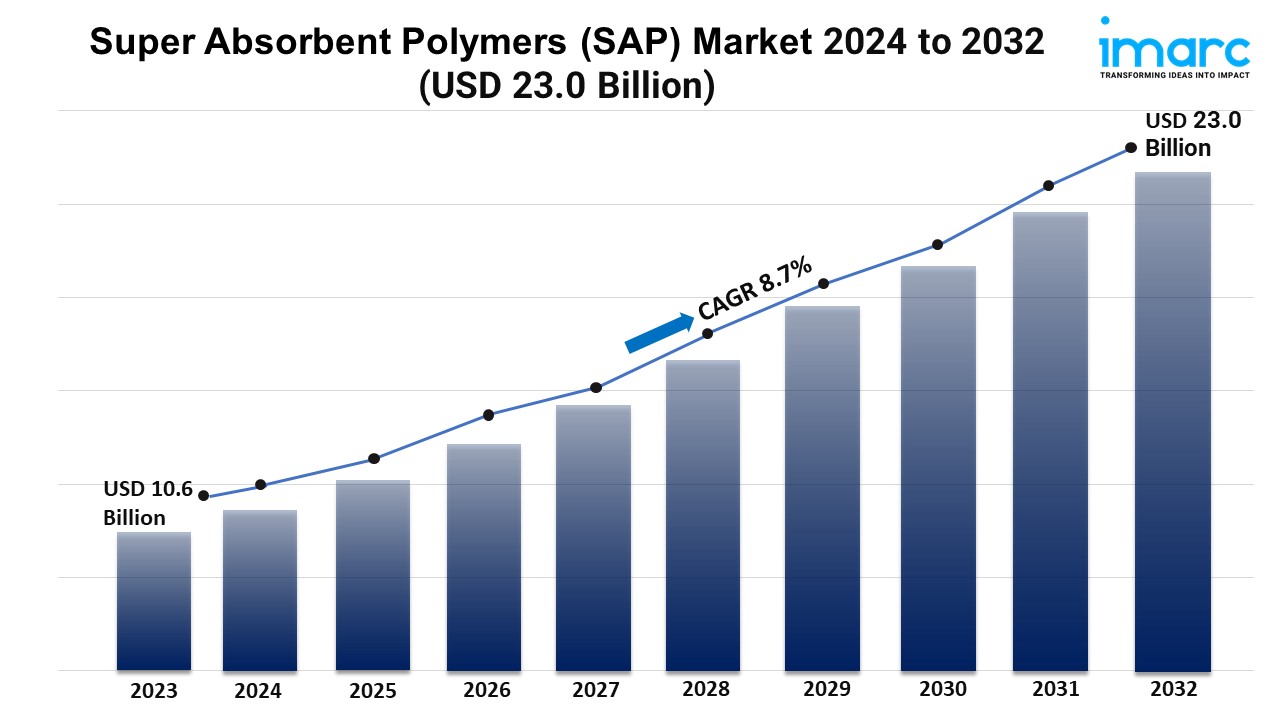Global Super Absorbent Polymers (SAP) Market Statistics: USD 23.0 Billion Value by 2032
Summary:
- The global super absorbent polymers (SAP) market size reached USD 10.6 Billion in 2023.
- The market is expected to reach USD 23.0 Billion by 2032, exhibiting a growth rate (CAGR) of 8.7% during 2024-2032.
- Asia Pacific leads the market, accounting for the largest super absorbent polymers (SAP) market share.
- Face care accounts for the majority of the market share in the product segment.
- Female holds the largest share in the personalized skin care products industry.
- Based on the pricing type, the market has been bifurcated into mass and premium.
- On the basis of the age group, the market has been divided into below 15 years, 15-25 years, 26-45 years, 46-60 years, and above 60 years.
- Offline represents the leading distribution channel segment.
- The growing awareness about skin health and ingredients is a primary driver of the personalized skin care products market.
- Technological advancements and the rising demand for customization are reshaping the personalized skin care products market.
Request for a sample copy of this report: https://www.imarcgroup.com/super-absorbent-polymers-market/requestsample
Industry Trends and Drivers:
- Technological advancements in skin care:
The integration of cutting-edge technologies like artificial intelligence (AI), machine learning (ML), and deoxyribonucleic acid (DNA)-based skin analysis is improving the functionality of personalized skin care products. AI-powered tools are able to analyze skin conditions in real time, using algorithms to detect subtle differences in skin texture, hydration levels, and even underlying concerns that are not visible to the naked eye. Additionally, DNA-based tests offer a scientific approach by evaluating genetic markers related to skin conditions, such as collagen breakdown, pigmentation, and sensitivity. These technologies enable brands to create hyper-personalized products that address specific issues, offering users a more targeted and effective skincare regimen. The accuracy and customization provided by these technologies build user trust and increase brand loyalty.
- Increasing demand for customization:
Individuals are seeking products tailored to their unique skin types, lifestyle habits, and environmental exposure. This shift is driven by a desire for more effective and individualized results as people are becoming more knowledgeable about their specific skin concerns, such as acne, dryness, or signs of aging. Many users are dissatisfied with one-size-fits-all products and prefer skincare regimens that are customized based on real-time data or specific diagnostic tests. Companies are responding to this demand by offering personalized skin care kits, virtual skin consultations, and customized subscription services, all of which allow for a more engaging and results-driven experience. The rising user interest in personalized skin care enhances brand loyalty as individuals feel a deeper connection to products specifically designed for their needs.
- Rising awareness about skin health and ingredients:
Individual are becoming more informed and conscious about the quality and composition of products they use on their skin, showing a strong preference for clean, natural, and sustainable ingredients. Many are opting for formulations that exclude harmful chemicals, allergens, or irritants, which may exacerbate skin conditions. The personalized approach enables users to select or receive products that are perfectly suited to their unique requirements, whether they seek solutions free from parabens, sulfates, or synthetic fragrances. The growing trend of ingredient transparency, where brands clearly display and explain each component in their formulas, is empowering users to make informed choices about what they apply to their skin.
Buy Full Report: https://www.imarcgroup.com/checkout?id=1896&method=502
Super Absorbent Polymers (SAP) Market Report Segmentation:
Breakup By Type:
- Sodium Polyacrylate
- Polyacrylate/Polyacrylamide Copolymer
- Others
Sodium polyacrylate exhibits a clear dominance in the market due to its excellent liquid retention and high absorbency, making it the preferred choice for hygiene products.
Breakup By Application:
- Personal Hygiene
- Agriculture
- Medical
- Industrial
- Others
Personal hygiene represents the largest segment as products like diapers, adult incontinence products, and feminine hygiene items rely heavily on SAPs.
Breakup By Production Method:
- Suspension Polymerization
- Solution Polymerization
- Gel Polymerization
Gel polymerization accounts for the majority of the market share because it provides a consistent, efficient process for producing high-performance polymers used in a variety of absorbent products.
Breakup By Region:
- North America (United States, Canada)
- Asia Pacific (China, Japan, India, South Korea, Australia, Indonesia, Others)
- Europe (Germany, France, United Kingdom, Italy, Spain, Russia, Others)
- Latin America (Brazil, Mexico, Others)
- Middle East and Africa
Asia Pacific dominates the market owing to the strong demand for hygiene products, driven by high standards of living, aging populations, and advanced healthcare systems.
Ask Analyst for Sample Report: https://www.imarcgroup.com/request?type=report&id=12746&flag=C
Top Super Absorbent Polymers (SAP) Market Leaders:
The super absorbent polymers (SAP) market research report outlines a detailed analysis of the competitive landscape, offering in-depth profiles of major companies. Some of the key players in the market are:
- BASF
- Evonik Industries
- Formosa Plastics Group
- Kao Corporation
- LG Chem Ltd.
- Nippon Shokubai
- Satellite Science and Technology Co. Ltd.
- SDP Global Co. Ltd.
- Sumitomo Seika Chemicals Company Ltd.
- Yixing Danson Technology Ltd.
If you require any specific information that is not covered currently within the scope of the report, we will provide the same as a part of the customization.
Other Trending Reports By IMARC Group:
Boom Lifts Market: https://www.imarcgroup.com/boom-lifts-market/requestsample
Millet Market: https://www.imarcgroup.com/millet-market/requestsample
Dehydrated Vegetables Market: https://www.imarcgroup.com/dehydrated-vegetables-market/requestsample
Mayonnaise Market: https://www.imarcgroup.com/prefeasibility-report-mayonnaise-manufacturing-plant/requestsample
Barcode Scanner Market: https://www.imarcgroup.com/barcode-scanner-market/requestsample
About Us:
IMARC Group is a global management consulting firm that helps the world’s most ambitious changemakers to create a lasting impact. The company provide a comprehensive suite of market entry and expansion services. IMARC offerings include thorough market assessment, feasibility studies, company incorporation assistance, factory setup support, regulatory approvals and licensing navigation, branding, marketing and sales strategies, competitive landscape and benchmarking analyses, pricing and cost research, and procurement research.
Media Contact
Company Name: IMARC Group
Contact Person: Elena Anderson
Email: Send Email
Phone: +1-631-791-1145
Address:134 N 4th St.
City: Brooklyn
State: NY
Country: United States
Website: https://www.imarcgroup.com

